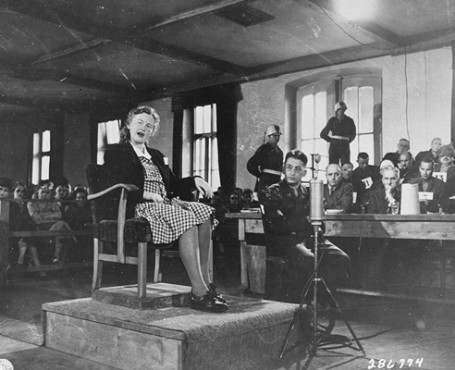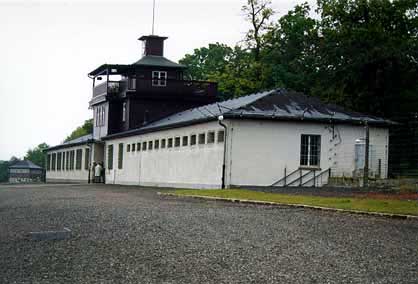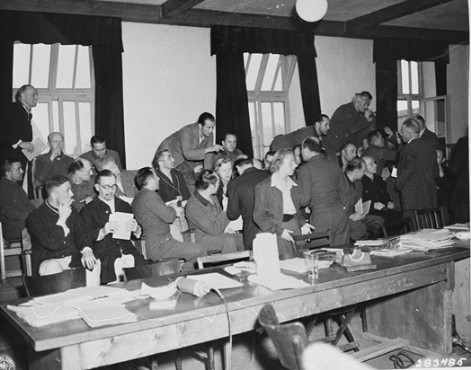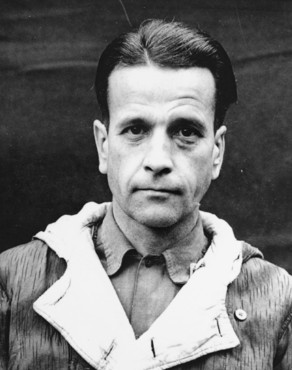Trial of Ilse Koch, continued...
Previous

Ilse Koch on the witness
stand in Dachau courtroom
Army Signal Corps photo
Just before the American liberators arrived
at Buchenwald on April 11, 1945, Karl Otto Koch, the husband
of Ilse Koch, had been executed by the Nazis themselves on April
5, 1945, two days before they began evacuating the Buchenwald
camp. Koch had been incarcerated in the Buchenwald camp prison
ever since he was arrested in August 1943 and tried in December
1943 by SS officer Dr. Georg Konrad Morgen in a special Nazi
court. Koch was found guilty of extortion, for taking bribes
from Jewish prisoners, and of two counts of murder for ordering
the deaths of two Buchenwald prisoners.
The recent photograph below shows the
gate house at Buchenwald. The camp prison, where Karl Otto Koch
was held, is the wing of the building that is in the foreground.

Gatehouse with camp
prison in the foreground
Ilse had also been arrested by the SS
for embezzlement and had been put on trial in Morgen's court,
along with her husband, but she had been acquitted of all charges.
Dr. Georg Konrad Morgen had investigated the human lamp shade
accusation, but had thrown this charge out of his court case
for lack of evidence. Ilse Koch had been implicated in the crime
of embezzlement at the Buchenwald camp because she shared a joint
bank account with her husband, who was accused of extorting the
equivalent of 100,000 dollars from the prisoners. As the wife
of the Commandant, she came under the jurisdiction of the SS
special court. She had been taken to the city jail in Weimar
in August 1943 to await her trial, and had never returned to
her former home just outside the Buchenwald camp.

Ilse Koch on the witness
stand, 7/14/1947
Credit: INP Soundphoto
Ilse Koch was the only woman among the
accused war criminals who were brought before the American Military
Tribunals at Dachau. When the photo above was taken, she was
seven months pregnant.
In the photograph below, her face can
be seen in the center, behind a woman who is standing at the
defense table. The woman who is standing is on the defense staff,
probably a stenographer or an interpreter.

Accused Buchenwald
war criminals confer with defense attorneys
According to a book entitled "The
Order of the Death's Head: The Story of Hitler's SS," by
Heinz Höhne, Otto Koch had extorted money from Jewish prisoners
who were sent to Buchenwald in November 1938 following the state-sponsored
pogrom known as Kristallnacht. Approximately 10,000 Jewish men
had been brought to Buchenwald in November 1938 but they were
offered the opportunity to be released if they promised to leave
Germany with their families within six months. Koch was accused
of taking money from these prisoners without official authorization.
Koch had also ordered the deaths of two prisoners, allegedly
in an attempt to cover up his misdeeds.
Another version of the story, according
to the Buchenwald Report commissioned by the US Army, is that
Koch had syphilis and he had ordered the deaths of two hospital
orderlies to prevent them from revealing his secret.
Before his crimes at Buchenwald were
uncovered, Commandant Karl Otto Koch had been transferred to
the Majdanek death camp in Poland in September 1941, but his
wife stayed behind, continuing to live in the Commandant's house.
According to the Buchenwald Report, it was rumored that Ilse
Koch was having simultaneous love affairs with Dr. Waldemar Hoven,
a Waffen-SS Captain who was the chief medical doctor at Buchenwald,
and Hermann Florstedt, the Deputy Commandant.

Dr. Waldemar Hoven
allegedly had an affair with Ilse Koch
Both Florstedt and Dr. Hoven were put
on trial in the special Nazi court, which was run by Dr. Georg
Konrad Morgen, also an officer in the Waffen-SS. Florstedt was
convicted by the Nazi court and was executed. Dr. Hoven, who
was a Communist sympathizer, was convicted of killing non-Communist
Buchenwald prisoners by injecting them in the heart. He was sentenced
to death by the SS court, but his sentence was never carried
out. After serving 18 months in the Buchenwald camp prison, he
was reprieved because there was a shortage of doctors in the
camp and his services were needed.
After the war, an International Military
Tribunal again charged Dr. Hoven with killing Buchenwald political
prisoners by injection. He was one of 23 Nazi doctors who were
put on trial in June 1947 in the case of USA vs. Karl Brandt
and others at Nuremberg, where he was again convicted of murder
and sentenced to death. Dr. Hoven was executed by hanging on
June 2, 1948.
At the Nuremberg International Military
Tribunal, on December 13, 1945, the US prosecution introduced
Exhibit #253, which consisted of three pieces of tanned human
skin that had been removed from prisoners by doctors at Buchenwald.
A forensic report confirmed that it was human skin. Although
this skin had not been fashioned into a lampshade, US prosecutor
Thomas Dodd claimed that Ilse Koch had ordered tattooed human
skin to be made into lampshades for her home. Exhibit #254, also
introduced by Dodd, was a shrunken head, allegedly used by Ilse
Koch as a paperweight, which Dodd claimed was the head of a Polish
prisoner at Buchenwald.
After World War II, no expense was spared
to educate the American public about the evil perpetrated by
Hitler's Third Reich and the horror of the concentration camps.
The photograph below shows a traveling exhibit of photographs,
enlarged to twice the size of life. This photo in the exhibit,
entitled "The living dead" was taken at Buchenwald.

Traveling exhibit of
Buchenwald photos
Fifty years later, the memories of the
horror of Buchenwald were still fresh. In a ceremony to commemorate
the 50ieth anniversary of the liberation of Buchenwald, one thousand
survivors of the camp participated along with some of the American
veterans who had liberated the camp. As quoted in an article
about this event by Stephen Kinzer in the New York Times International,
one of the former inmates shared his memories of Ilse Koch:
"She was a very beautiful woman
with long red hair, but any prisoner who was caught looking at
her could be shot," recalled Kurt Glass, a former inmate
who worked as a gardener at the Koch family villa. "She
got the idea she would like lamp shades made of human skin, and
one day on the Appellplatz we were all ordered to strip to the
waist. The ones who had interesting tattoos were brought to her,
and she picked out the ones she liked. Those people were killed
and their skin was made into lampshades for her. She also used
mummified human thumbs as light switches in her house."
If the human thumb light switches were
ever found, they were not introduced as evidence into the trial
of Ilse Koch.
Continue
Previous
Back
to Buchenwald trial
Back
to Buchenwald home page
Back
to Dachau Trials
Home
This page was last updated on January
26, 2009
Trial of Ilse Koch, continued...Previous Just before the American liberators arrived at Buchenwald on April 11, 1945, Karl Otto Koch, the husband of Ilse Koch, had been executed by the Nazis themselves on April 5, 1945, two days before they began evacuating the Buchenwald camp. Koch had been incarcerated in the Buchenwald camp prison ever since he was arrested in August 1943 and tried in December 1943 by SS officer Dr. Georg Konrad Morgen in a special Nazi court. Koch was found guilty of extortion, for taking bribes from Jewish prisoners, and of two counts of murder for ordering the deaths of two Buchenwald prisoners. The recent photograph below shows the gate house at Buchenwald. The camp prison, where Karl Otto Koch was held, is the wing of the building that is in the foreground.  Ilse had also been arrested by the SS for embezzlement and had been put on trial in Morgen's court, along with her husband, but she had been acquitted of all charges. Dr. Georg Konrad Morgen had investigated the human lamp shade accusation, but had thrown this charge out of his court case for lack of evidence. Ilse Koch had been implicated in the crime of embezzlement at the Buchenwald camp because she shared a joint bank account with her husband, who was accused of extorting the equivalent of 100,000 dollars from the prisoners. As the wife of the Commandant, she came under the jurisdiction of the SS special court. She had been taken to the city jail in Weimar in August 1943 to await her trial, and had never returned to her former home just outside the Buchenwald camp.  Ilse Koch was the only woman among the accused war criminals who were brought before the American Military Tribunals at Dachau. When the photo above was taken, she was seven months pregnant. In the photograph below, her face can be seen in the center, behind a woman who is standing at the defense table. The woman who is standing is on the defense staff, probably a stenographer or an interpreter.  According to a book entitled "The Order of the Death's Head: The Story of Hitler's SS," by Heinz Höhne, Otto Koch had extorted money from Jewish prisoners who were sent to Buchenwald in November 1938 following the state-sponsored pogrom known as Kristallnacht. Approximately 10,000 Jewish men had been brought to Buchenwald in November 1938 but they were offered the opportunity to be released if they promised to leave Germany with their families within six months. Koch was accused of taking money from these prisoners without official authorization. Koch had also ordered the deaths of two prisoners, allegedly in an attempt to cover up his misdeeds. Another version of the story, according to the Buchenwald Report commissioned by the US Army, is that Koch had syphilis and he had ordered the deaths of two hospital orderlies to prevent them from revealing his secret. Before his crimes at Buchenwald were uncovered, Commandant Karl Otto Koch had been transferred to the Majdanek death camp in Poland in September 1941, but his wife stayed behind, continuing to live in the Commandant's house. According to the Buchenwald Report, it was rumored that Ilse Koch was having simultaneous love affairs with Dr. Waldemar Hoven, a Waffen-SS Captain who was the chief medical doctor at Buchenwald, and Hermann Florstedt, the Deputy Commandant.  Both Florstedt and Dr. Hoven were put on trial in the special Nazi court, which was run by Dr. Georg Konrad Morgen, also an officer in the Waffen-SS. Florstedt was convicted by the Nazi court and was executed. Dr. Hoven, who was a Communist sympathizer, was convicted of killing non-Communist Buchenwald prisoners by injecting them in the heart. He was sentenced to death by the SS court, but his sentence was never carried out. After serving 18 months in the Buchenwald camp prison, he was reprieved because there was a shortage of doctors in the camp and his services were needed. After the war, an International Military Tribunal again charged Dr. Hoven with killing Buchenwald political prisoners by injection. He was one of 23 Nazi doctors who were put on trial in June 1947 in the case of USA vs. Karl Brandt and others at Nuremberg, where he was again convicted of murder and sentenced to death. Dr. Hoven was executed by hanging on June 2, 1948. At the Nuremberg International Military Tribunal, on December 13, 1945, the US prosecution introduced Exhibit #253, which consisted of three pieces of tanned human skin that had been removed from prisoners by doctors at Buchenwald. A forensic report confirmed that it was human skin. Although this skin had not been fashioned into a lampshade, US prosecutor Thomas Dodd claimed that Ilse Koch had ordered tattooed human skin to be made into lampshades for her home. Exhibit #254, also introduced by Dodd, was a shrunken head, allegedly used by Ilse Koch as a paperweight, which Dodd claimed was the head of a Polish prisoner at Buchenwald. After World War II, no expense was spared to educate the American public about the evil perpetrated by Hitler's Third Reich and the horror of the concentration camps. The photograph below shows a traveling exhibit of photographs, enlarged to twice the size of life. This photo in the exhibit, entitled "The living dead" was taken at Buchenwald.  Fifty years later, the memories of the horror of Buchenwald were still fresh. In a ceremony to commemorate the 50ieth anniversary of the liberation of Buchenwald, one thousand survivors of the camp participated along with some of the American veterans who had liberated the camp. As quoted in an article about this event by Stephen Kinzer in the New York Times International, one of the former inmates shared his memories of Ilse Koch: "She was a very beautiful woman with long red hair, but any prisoner who was caught looking at her could be shot," recalled Kurt Glass, a former inmate who worked as a gardener at the Koch family villa. "She got the idea she would like lamp shades made of human skin, and one day on the Appellplatz we were all ordered to strip to the waist. The ones who had interesting tattoos were brought to her, and she picked out the ones she liked. Those people were killed and their skin was made into lampshades for her. She also used mummified human thumbs as light switches in her house." If the human thumb light switches were ever found, they were not introduced as evidence into the trial of Ilse Koch. ContinuePreviousBack to Buchenwald trialBack to Buchenwald home pageBack to Dachau TrialsHomeThis page was last updated on January 26, 2009 |